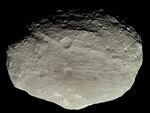Astronomy:Kepler-70
| Observation data Equinox J2000.0]] (ICRS) | |
|---|---|
| Constellation | Cygnus[note 1] |
| Right ascension | 19h 45m 25.47457s[1] |
| Declination | +41° 05′ 33.8822″[1] |
| Apparent magnitude (V) | 14.87[2] |
| Characteristics | |
| Spectral type | sdB[3] |
| Apparent magnitude (U) | 13.80[2] |
| Apparent magnitude (B) | 14.71[2] |
| Apparent magnitude (R) | 15.43[2] |
| Apparent magnitude (I) | 15.72[2] |
| Apparent magnitude (J) | 15.36[2] |
| Apparent magnitude (H) | 15.59[2] |
| Astrometry | |
| Proper motion (μ) | RA: 7.217(29)[1] mas/yr Dec.: −3.148(30)[1] mas/yr |
| Parallax (π) | 0.9086 ± 0.0247[1] mas |
| Distance | 3,590 ± 100 ly (1,100 ± 30 pc) |
| Details | |
| Mass | 0.496 ± 0.002[3] M☉ |
| Radius | 0.203 ± 0.007[3] R☉ |
| Luminosity (bolometric) | 22.9 ± 3.1 L☉ |
| Temperature | 27,730 ± 260[3] K |
| Other designations | |
| Database references | |
| SIMBAD | data |
| KIC | data |
Kepler-70, also known as KIC 5807616 and KOI-55, is a star about 3,600 light-years (1,100 parsecs) away in the constellation Cygnus, with an apparent visual magnitude of 14.87.[2] This is too faint to be seen with the naked eye; viewing it requires a telescope with an aperture of 40 cm (20 in) or more.[4] A subdwarf B star, Kepler-70 passed through the red giant stage some 18.4 million years ago. In its present-day state, it is fusing helium in its core. Once it runs out of helium it will contract to form a white dwarf. It has a relatively small radius of about 0.2 times the Sun's radius; white dwarfs are generally much smaller.[5] The star may be host to a planetary system with two planets,[6] although later research[7][8] indicates that this is not in fact the case.
Properties
Kepler-70 is an sdB (B-type subdwarf star with a temperature of 27,730 K,[9] equivalent to that of a B0-type star. It has a luminosity of 18.9 L☉,[10][9] a radius of 0.203 R☉, and a mass about half of that of the sun. The star was an evolutionary giant less than 20 million years ago.[10]
Kepler-70 is still fusing.[9][10] When it runs out of helium, it will contract into a white dwarf.[10]
Planetary system
On December 26, 2011, evidence for two extremely short-period planets, Kepler-70b and Kepler-70c, was announced by Charpinet et al.[6] They were detected by the reflection of starlight caused by the planets themselves, rather than through a variation in apparent stellar magnitude caused by them transiting the star.
The measurements also suggested a smaller body between the two candidate planets; this remains unconfirmed.
If these planets exist, then the orbits of Kepler-70b and Kepler-70c have 7:10 orbital resonance and have the closest approach between planets of any known planetary system. However, later research[7] suggested that what had been detected was not in fact the reflection of light from exoplanets, but star pulsation "visible beyond the cut-off frequency of the star." Further research[8] indicated that star pulsation modes were indeed the more likely explanation for the signals found in 2011, and that the two exoplanets probably did not exist.
If Kepler-70b exists, then it would have a temperature of about 7288 K,[10] the same as that of an F0 star. The hottest confirmed exoplanet and the hottest with a measured temperature is KELT-9b, with a temperature of about 4,600 K.[11]
| Companion (in order from star) |
Mass | Semimajor axis (AU) |
Orbital period (days) |
Eccentricity | Inclination | Radius |
|---|---|---|---|---|---|---|
| b (unconfirmed) | 0.440 M⊕ | 0.0060 | 0.2401 | — | 20–80, likely 65[note 2]° | 0.759 R⊕ |
| c (unconfirmed) | 0.655 M⊕ | 0.0076 | 0.34289 | — | 20–80, likely 65° | 0.867 R⊕ |
Notes
References
- ↑ 1.0 1.1 1.2 1.3 Vallenari, A. et al. (2022). "Gaia Data Release 3. Summary of the content and survey properties". Astronomy & Astrophysics. doi:10.1051/0004-6361/202243940 Gaia DR3 record for this source at VizieR.
- ↑ 2.0 2.1 2.2 2.3 2.4 2.5 2.6 2.7 2.8 "KPD 1943+4058". SIMBAD. Centre de données astronomiques de Strasbourg. http://simbad.u-strasbg.fr/simbad/sim-basic?Ident=KPD+1943%2B4058.
- ↑ 3.0 3.1 3.2 3.3 "Notes for Planet KOI-55 b". Extrasolar Planets Encyclopaedia. https://exoplanet.eu/catalog/koi_55_b--1037/.
- ↑ Sherrod, P. Clay; Koed, Thomas L. (2003), A Complete Manual of Amateur Astronomy: Tools and Techniques for Astronomical Observations, Astronomy Series, Courier Dover Publications, p. 9, ISBN 0-486-42820-6, https://books.google.com/books?id=4zjv84hHNPcC&pg=PA9
- ↑ Cain, Fraser (4 February 2009). "White Dwarf Stars". Universe Today. http://www.universetoday.com/24681/white-dwarf-stars/.
- ↑ 6.0 6.1 6.2 Charpinet, S. et al. (December 21, 2011), "A compact system of small planets around a former red-giant star", Nature 480 (7378): 496–499, doi:10.1038/nature10631, PMID 22193103, Bibcode: 2011Natur.480..496C
- ↑ 7.0 7.1 Krzesinski, J. (August 25, 2015), "Planetary candidates around the pulsating sdB star KIC 5807616 considered doubtful", Astronomy & Astrophysics 581: A7, doi:10.1051/0004-6361/201526346, Bibcode: 2015A&A...581A...7K
- ↑ 8.0 8.1 Blokesz, A.; Krzesinski, J.; Kedziora-Chudczer, L. (4 July 2019), "Analysis of putative exoplanetary signatures found in light curves of two sdBV stars observed by Kepler", Astronomy & Astrophysics 627: A86, doi:10.1051/0004-6361/201835003, Bibcode: 2019A&A...627A..86B
- ↑ 9.0 9.1 9.2 jamesrushford (2013-10-22). "Kepler 70b: The Coolest Exoplanet" (in en-US). https://sites.coloradocollege.edu/pc120ml/2013/10/22/kepler-70b-the-coolest-exoplanet/.
- ↑ 10.0 10.1 10.2 10.3 10.4 jarrettkong (2013-10-23). "Kepler-70b: The Remnant of a Time Long Past" (in en-US). https://sites.coloradocollege.edu/pc120ml/2013/10/23/kepler-70b-the-remnant-of-a-time-long-past/.
- ↑ Jones, K. et al. (October 2022). "The stable climate of KELT-9b". Astronomy & Astrophysics 666: A118. doi:10.1051/0004-6361/202243823. Bibcode: 2022A&A...666A.118J.
External links
 |




